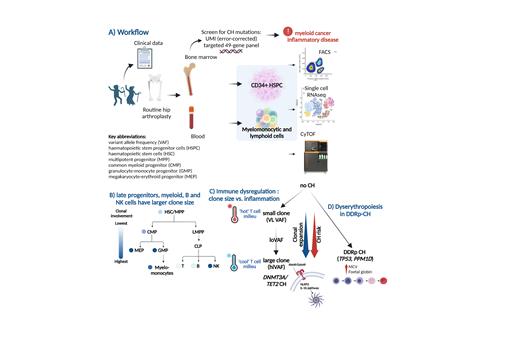Clonal haematopoiesis (CH) describes age-related clonal expansion of mutant haematopoietic cells in the absence of overt haematological disease. Growing evidence suggests that individuals with ‘high risk’ (HR-CH) have increased risk of blood cancer, auto-inflammatory and cerebro-cardiovascular disease. We aimed to better understand genomic and immunological events associated with progression of CH. By setting up a cohort of individuals undergoing hip arthroplasty ( n=432, 58% female, age range 50-90, mean 69 years), we detected CH mutations (sensitivity to 0.2% variant allele frequency, VAF) in 38 % of individuals. We studied their haematopoietic and immune landscape to gain deeper insights into the impact of CH.
50 individuals (12% of total) had mutational features of HR-CH including VAF>10% (hiVAF CH, n=25, 88% are DNMT3A or TET2 ‘DT’ mutant) or DNA-damage repair pathway gene mutations (DDRp CH, n=16 , TP53, PPM1D, PHF6 mutant). We also identified low risk CH with VAF of 2-10% (loVAF CH, n=50, 82% DT mutant) and CH with very low VAF of 0.2-2% (VL CH, n=64, 51% DT mutant). Although most CH individuals have ‘normal’ blood indices, compared with non-CH, hiVAF but not loVAF CH shows a trend of raised monocytes (p=0.097). DDRp CH individuals had a trend of lower Haemoglobin (Hb, p=0.05) and significantly raised red cell mean corpuscular volume (MCV, p<0.01). To elucidate the biology of CH, we created a multiomic atlas including genomic analyses, single cell transcriptomes and deep cytometry of haematopoietic and immune cell populations in marrow and blood.
In flow-sorted populations (n=14), erythro-myeloid progenitors (CMP/MEP/GMP) had higher VAF than CD34+38- cells (HSC/MPP), indicating greater clonal expansion in more mature progenitors. Compared with T cells, where mutations were rare, we detected higher CH mutation VAF in monocytes (p<0.01), and NK (p<0.01) cells. This reflects the different origins of lymphoid cells, but also highlights possible mutation-driven altered function particular in innate immune cells. Furthermore, we surmise that clone size estimation by VAF in bulk genotyping reflects expansion more mature cells rather than that of HSC.
Using multi-panel Mass Cytometry (CyTOF) profiling of blood and marrow, there are significantly increased CD4+ (p<0.05) and CD8+ (p<0.05) cytotoxic T-cells, and classical dendritic cells (p<0.05) with a trend increase in CD169+ monocytes/ macrophages in VL CH individuals, independent of their DT mutant status. In contrast, hiVAF CH samples have fewer of these anti-viral/ anti-tumoral immune cells, and more regulatory T-cells (Treg, p<0.05). The lack of CH mutations in T-cells, and the very low level mutations even in myelomonocytic cells in VL CH, suggest that these immune profile changes are likely due to indirect or non-cell autonomous effects with respect to mutant cells. Our data indicate that while CH may arise in an inflammatory environment and leads to immune dysregulation favouring clonal growth, a “cool”, suppressive T cell immune environment particularly in hiVAF CH may permit unchecked clonal expansion. In single cell RNAseq data, marrow HSPCs and myelo-erythroid cells in hiVAF CH display transcriptomic myelomonocytic bias (e.g. higher CEBPBexpression) and increased expression of inflammasome (PAMP/DAMP and NLR) signatures. Raised blood monocyte counts observed were correlated with expanded (1.45-fold) myelocyte/promonocyte subpopulations, but there was no expansion of CD34+ HSPC. These data also raise the possibility that this pro-inflammatory state modulates the adaptive immune microenvironment to promote clonal growth. We are performing detailed analyses of longitudinal samples to address these hypotheses.
In contrast, DDRp CH individuals had significantly expanded early HSPC (HSC/MPP, 1.45-fold, p<0.01; and CMP, 1.2-fold, p<0.05) but reduced lineage-committed progenitors GMP (p=0.05) and MEP (p<0.05) compared with non-CH. Also, in DDRp CH we detected aberrant accelerated erythroid differentiation coupled with persistent expression of foetal haemoglobin, a finding consistent with lower Hb, raised MCV and dyserythropoiesis.
In summary, our combined approach in this large cohort of CH individuals reveals distinct genomic and immunological signals which underpin clonal expansion, and provide single-cell resolution of pro-inflammatory and pre-leukaemic states in different types of CH.
Disclosures
Hasan:Bristol Myers Squibb: Current Employment, Current equity holder in publicly-traded company. Suragani:Bristol Myers Squibb: Current Employment, Current equity holder in publicly-traded company. Carmichael:Bristol Myers Squibb: Current Employment, Current equity holder in publicly-traded company. Gandhi:Bristol Myers Squibb: Current Employment, Current equity holder in publicly-traded company.


